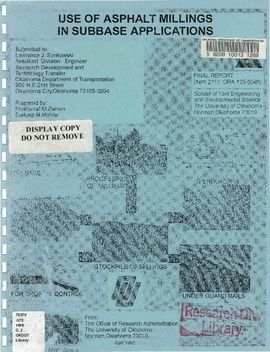| dc.description.abstract | Asphalt Concrete (AC) pavements, after a certain period of their service life, exhibit various types of deterioration and damage.
To remedy these problems and to increase road safety, they are often overlaid with a new layer of asphalt concrete. Sometimes
the old asphalt pavement is milled, and the millings, after being treated with certain chemicals, are used as an overlay.
However, the asphalt millings are not entirely utilized in producing recycled asphalt pavements (RAP). Due to environmental
as well as economical considerations it is necessary to find alternate uses for these millings. The overall objective of this study
is to find how asphalt millings are currently used in Oklahoma, the volume of millings produced in the State, and whether the
millings could be used in subbase construction.
A comprehensive literature search was carried out to obtain articles and reports relevant to asphalt millings. The eight
Divisions of ODOT were visited and pertinent people from each Division were interviewed. To enhance the information
collection process, a questionnaire was prepared in collaboration with the Research, Development and Technology Transfer
unit at ODOT for the Divisional people to fill out. The interviews mainly focused on the current milling operations, recycling
of millings, methods followed, current use of millings, and potential future use. Photographs of milling operations and milling
applications were taken during certain site visits and are included in this report. Also, milling samples were collected during
some of these site visits.
The literature survey indicates that processed millings have been used extensively in a variety of applications like shoulder,
mailbox turnouts, parking lots, level-up operations, and base/subbase applications in the United States. The divisional
interviews revealed that the eight Divisions of ODOT also carry out extensive recycling of asphalt millings. However, due to
lack of definite guidelines/specifications for the use of millings in various applications, there have been certain project failures.
Aggregate gradation, age of asphalt, milling process, speed of milling operations, age of stockpile and depth of cut primarily
affect the quality of millings. Interviews revealed that due to a lack of specific guidelines in subbase application, which are
considered critical, the Divisions of ODOT are hesitant in using millings as subbase.
From the study it is concluded that a testing methodology must be introduced for determining the quality of millings in terms
of their physical and mechanical properties, relative to their intended use. | |
